This step by step woodworking project is about trash cabinet plans. This article features detailed instructions for building a simple wood cabinet for a plastic trash can. We have designed the plans to keep the expenditures under control and to involve the least amount of work possible. These are the easiest recycling cabinet plans you will find on internet.
When buying the lumber, you should select the planks with great care, making sure they are straight and without any visible flaws (cracks, knots, twists, decay). Use a spirit level to plumb and align the components, before inserting the galvanized screws, otherwise the wooden cabinet won’t have a symmetrical look. If you have all the materials and tools required for the project, you could get the job done in about a day. See all my Premium Plans HERE.
Projects made from these plans
Trash Cabinet Plans
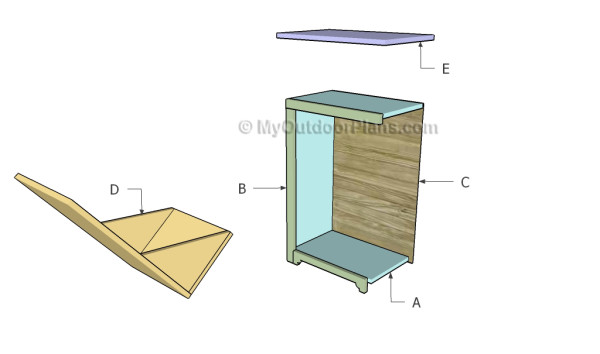
Building a trash can cabinet
Cut & Shopping Lists
- A – 2 pieces of 1×12 lumber – 29 1/4″ long, 1 piece – 17 1/2″ long, 1 piece – 19″ long FRAME
- B – 2 pieces of 1×2 lumber – 28 1/2″ long, 1 piece – 19″ long, 1 piece of 1×3 lumber – 16″ long TRIMS
- C – 1 piece of 1/4″ plywood – 19″x28 1/2″ long BACK
- D – 1 piece of 1×12 lumber – 15 3/4″ long, 2 pieces – 11 1/4″ long, 1 piece of plywood 3/4″ plywood – 15 3/4″x25 3/4″ long DOOR
- E – 1 piece of 1×14 lumber – 21″ long TOP
- 1 piece of 1×14 lumber – 2 ft
- 2 pieces of 1×12 lumber – 8 ft
- 1 piece of 1×3 lumber – 2 ft
- 1 piece of 1/4″ plywood – 2’x3′
- 1 piece of 1×2 lumber – 8 ft
- handle, hinges
- 1 1/4″ screws
- 1 5/8″ screws
- 2 1/2″ screws
- filler, stain
- glue
Tools
![]() Hammer, Tape measure, Framing square, Level
Hammer, Tape measure, Framing square, Level
![]() Miter saw, Drill machinery, Screwdriver, Sander
Miter saw, Drill machinery, Screwdriver, Sander
Time
![]() One day
One day
How to build a trash cabinet

Building the sides
The first step of the project is to build the sides for the trash can cabinet. As you can easily notice in the diagram, we recommend you to Mark the cut lines on the wooden planks and to get the job done with a jigsaw. Smooth the edges with fine grit sandpaper and remove the residues with a damp cloth. Drill pocket holes along the top edges of the side components.
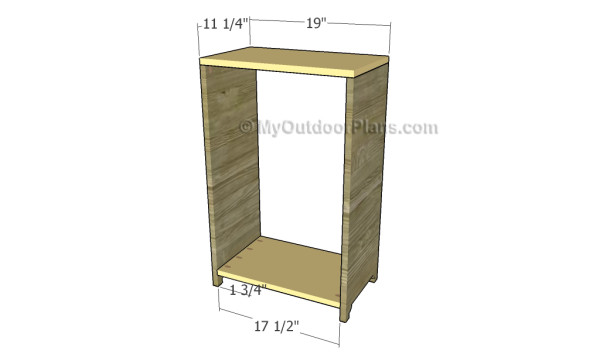
Assembling the frame of the recycling cabinet
Next, you need to attach the top and the bottom to the sides of the cabinet. Insert 1 1/4″ screws through the pocket holes drilled along the top edges of the sides. Add glue to the joints and make sure the corners are right-angled. Drill pocket holes at both ends of the bottom component and insert 1 1/4″ screws into the sides. Check if the corners are square before inserting the screws.
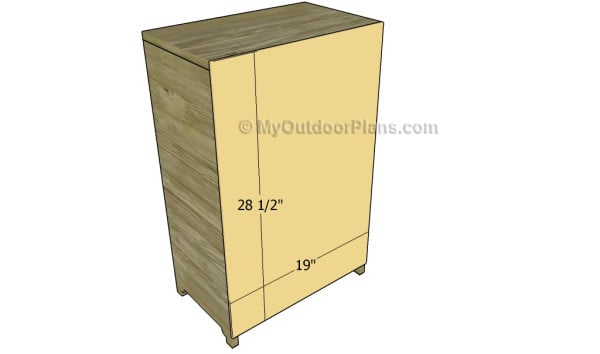
Attaching the back
Cut a piece of 1/4″ plywood and attach it to the back of the cabinet, as shown in the diagram. Use glue and brad nails to secure the sheet to the frame of the trash cabinet.
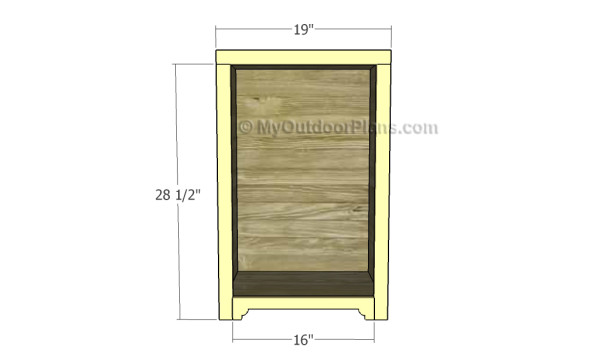
Fitting the front trims
Use 1×2 lumber to build the trims for the front face of the cabinet. The bottom trim will be built using 1×3 lumber. Align the edges with attention and drive in brad nails to lock the trims into place. Add glue to add strength to the joints and leave no gap between the components.
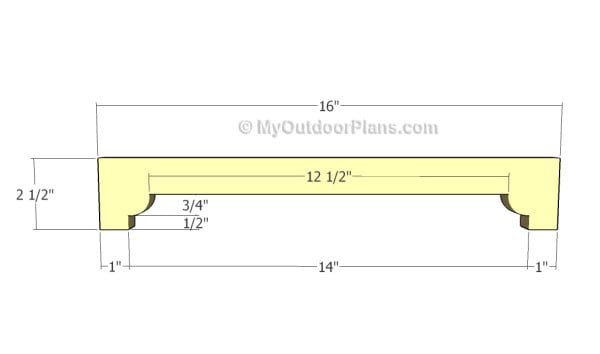
Front bottom trim
Mark the cut lines on the 1×3 slat and get the job done with a jigsaw. These little details make for a great impact, so make sure you smooth the edges after making the cuts.
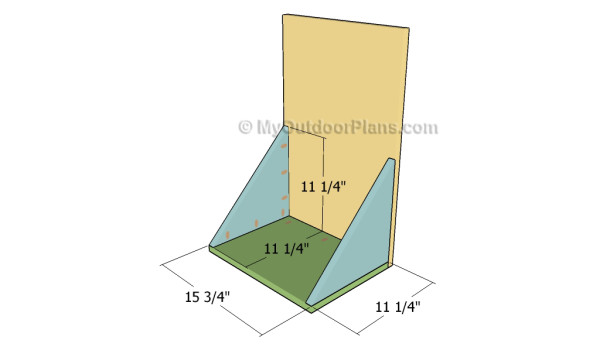
Building the base of the trash can
Building the base of the tilt out door is easy, but you need to follow the instructions from the diagonal. Build the side by making a diagonal cut to a 1×12 slat. Drill pocket holes to the components, as shown in the diagram. Insert 1 1/4″ screws to secure the sides to the bottom component.
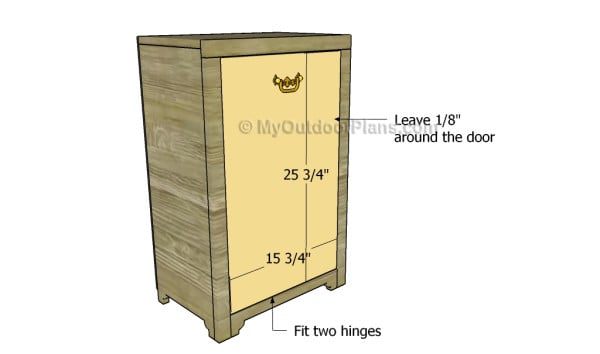
Fit the door
Use plywood for the door. Make sure you leave 1/8″ around all edges and secure it to the cabinet using hinges. Attach the handle to the door, as well as a hardware that stops it from fall all way down.
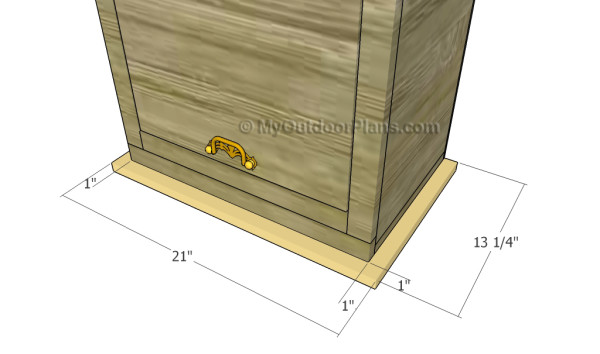
Attaching the top component
Although this step is optional, if you are going to use the cabinet as a stand alone piece, it would look nice. Cut a piece of 1×14 lumber and center the cabinet as in the diagram. Add glue to the joints and insert a few 1 1/4″ screws through the top of they cabinet into the 1×14 component. Leave it several hours to make sure the glue has dried out.

Trash cabinet plans
One of the last steps of the woodworking project is to take care of the finishing touches. Therefore, fill the pilot holes with wood putty and smooth the surface with 120-grit sandpaper.
Top Tip: If you want to enhance the look of the project and to protect the wooden recycling cabinet from decay, we recommend you to cover the components with paint or stain.
This woodworking project was about farmhouse trash can tilt out cabinet plans. If you want to see more outdoor plans, we recommend you to check out the rest of our step by step projects. LIKE us on Facebook and Google + to be the first that gets out latest projects and to hep us keep adding free woodworking plans for you.
